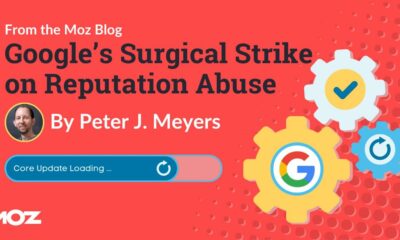SEO
Google Debuts 9 New Shopping Features

Google shopping experience for users is getting an upgrade. In today’s Search On event, Google announced nine new features and tools geared to help improve the user experience.
The overarching theme of the updates is visualization and personalization.
Visualization Shopping Features
Google emphasized that users spend a lot of time researching, exploring, and discovering their options before purchasing. Four visual features for users Google announced:
- Search with the word “shop”. By starting your search with “shop” followed by what you’re searching for, you’ll now see a visual feed that includes products, research tools, and nearby inventory. This update also expands the shopping experience beyond apparel. It’s now available in all categories on mobile.
- Shop the look. For the apparel category, users will now be able to “shop the look” which showcases individual products to help create an entire outfit. Google’s tool will show complimentary products to the main product a user is searching for, such as handbags or shoes to go along with a top or jacket.
- Trending products feature. This is a new feature in Search which will show popular products in the category users are searching for. Google confirmed this will be available later this Fall.
- 3D shopping. Expanding on the earlier launch of 3D shopping for home goods, 3D visuals of sneakers are coming in the following months.
Further, Google announced a way to build and create 3D visuals because they understand creating this type of asset takes a lot of time and resources. Their tool will use machine learning to automate 360-degree spins using a few still images.
Encouraging Confident Purchasing
The next set of tools announced from Google are geared to help users make more informed decisions when purchasing.
- Guides for complex purchases. Google announced a buying guide for complex purchase decisions. The buying guide will consist of insights about that category from a range of trusted sources.
- See what others are saying. Specifically, in the Google app, Page Insights will be available. This feature bridges content on a website users are on or a product being researched, along with ratings, pros and cons, in one single view.
A More Personalized Shopping Experience
The last set of updates focuses on the individual shopping experience, including privacy preference enhancements.
- More personalized results. Users will start getting personalized shopping results based on their previous shopping habits. To protect user privacy with this enhancement, users will have the ability to tell Google their preferences directly, as well as easy-to-use controls to toggle the feature on or off.
- Shop with dynamic filters. Search filters will now adapt to real-time Search trends, meaning the filters are not static.
- Using Discover app for more inspiration. Users who have the Google app will start seeing style suggestions in the Discover tab based on their shopping behavior.If a user sees something they like, they can click on the product and Lens will open up to provide available options on where to buy.
Next Steps For Advertisers
While the Search On event focused on the user experience, many advertisers are wondering how they should prepare for these updates.
For advertisers in the E-Commerce space, make sure your Merchant Center for Shopping Ads is in tip-top shape. This can include optimizing images, descriptions, titles, and including as many specifications as possible so users can better find your products.
More information is coming for marketers to help understand how these user experience updates will affect advertisers. We’ll continue to report on follow-ups from Google as they are announced.
Featured image: Vladimka production/Shutterstock
SEO
Competing Against Brands & Nouns Of The Same Name

Establishing and building a brand has always been both a challenge and an investment, even before the days of the internet.
One thing the internet has done, however, is make the world a lot smaller, and the frequency of brand (or noun) conflicts has greatly increased.
In the past year, I’ve been emailed and asked questions about these conflicts at conferences more than I have in my entire SEO career.
When you share your brand name with another brand, town, or city, Google has to decide and determine the dominant user interpretation of the query – or at least, if there are multiple common interpretations, the most common interpretations.
Noun and brand conflicts typically happen when:
- A rebrand’s research focuses on other business names and doesn’t take into consideration general user search.
- When a brand chooses a word in one language, but it has a use in another.
- A name is chosen that is also a noun (e.g. the name of a town or city).
Some examples include Finlandia, which is both a brand of cheese and vodka; Graco, which is both a brand of commercial products and a brand of baby products; and Kong, which is both the name of a pet toy manufacturer and a tech company.
User Interpretations
From conversations I’ve had with marketers and SEO pros working for various brands with this issue, the underlying theme (and potential cause) comes down to how Google handles interpretation of what users are looking for.
When a user enters a query, Google processes the query to identify known entities that are contained.
It does this to improve the relevance of search results being returned (as outlined in its 2015 Patent #9,009,192). From this, Google also works to return related, relevant results and search engine results page (SERP) elements.
For example, when you search for a specific film or TV series, Google may return a SERP feature containing relevant actors or news (if deemed relevant) about the media.
This then leads to interpretation.
When Google receives a query, the search results need to often cater for multiple common interpretations and intents. This is no different when someone searches for a recognized branded entity like Nike.
When I search for Nike, I get a search results page that is a combination of branded web assets such as the Nike website and social media profiles, the Map Pack showing local stores, PLAs, the Nike Knowledge Panel, and third-party online retailers.
This variation is to cater for the multiple interpretations and intents that a user just searching for “Nike” may have.
Brand Entity Disambiguation
Now, if we look at brands that share a name such as Kong, when Google checks for entities and references against the Knowledge Graph (and knowledge base sources), it gets two closer matches: Kong Company and Kong, Inc.
The search results page is also littered with product listing ads (PLAs) and ecommerce results for pet toys, but the second blue link organic result is Kong, Inc.
Also on page one, we can find references to a restaurant with the same name (UK-based search), and in the image carousel, Google is introducing the (King) Kong film franchise.
It is clear that Google sees the dominant interpretation of this query to be the pet toy company, but has diversified the SERP further to cater for secondary and tertiary meanings.
In 2015, Google was granted a patent that included features of how Google might determine differences in entities of the same name.
This includes the possible use of annotations within the Knowledge Base – such as the addition of a word or descriptor – to help disambiguate entities with the same name. For example, the entries for Dan Taylor could be:
- Dan Taylor (marketer).
- Dan Taylor (journalist).
- Dan Taylor (olympian).
How it determines what is the “dominant” interpretation of the query, and then how to order search results and the types of results, from experience, comes down to:
- Which results users are clicking on when they perform the query (SERP interaction).
- How established the entity is within the user’s market/region.
- How closely the entity is related to previous queries the user has searched (personalization).
I’ve also observed that there is a correlation between extended brand searches and how they affect exact match branded search.
It’s also worth highlighting that this can be dynamic. Should a brand start receiving a high volume of mentions from multiple news publishers, Google will take this into account and amend the search results to better meet users’ needs and potential query interpretations at that moment in time.
SEO For Brand Disambiguation
Building a brand is not a task solely on the shoulders of SEO professionals. It requires buy-in from the wider business and ensuring the brand and brand messaging are both defined and aligned.
SEO can, however, influence this effort through the full spectrum of SEO: technical, content, and digital PR.
Google understands entities on the concept of relatedness, and this is determined by the co-occurrence of entities and then how Google classifies and discriminates between those entities.
We can influence this through technical SEO through granular Schema markup and by making sure the brand name is consistent across all web properties and references.
This ties into how we then write about the brand in our content and the co-occurrence of the brand name with other entity types.
To reinforce this and build brand awareness, this should be coupled with digital PR efforts with the objective of brand placement and corroborating topical relevance.
A Note On Search Generative Experience
As it looks likely that Search Generative Experience is going to be the future of search, or at least components of it, it’s worth noting that in tests we’ve done, Google can, at times, have issues when generative AI snapshots for brands, when there are multiple brands with the same name.
To check your brand’s exposure, I recommend asking Google and generating an SGE snapshot for your brand + reviews.
If Google isn’t 100% sure which brand you mean, it will start to include reviews and comments on companies of the same (or very similar) name.
It does disclose that they are different companies in the snapshot, but if your user is skim-reading and only looking at the summaries, this could be an accidental negative brand touchpoint.
More resources:
Featured Image: VectorMine/Shutterstock
SEO
Google Rolls Out New ‘Web’ Filter For Search Results

Google is introducing a filter that allows you to view only text-based webpages in search results.
The “Web” filter, rolling out globally over the next two days, addresses demand from searchers who prefer a stripped-down, simplified view of search results.
Danny Sullivan, Google’s Search Liaison, states in an announcement:
“We’ve added this after hearing from some that there are times when they’d prefer to just see links to web pages in their search results, such as if they’re looking for longer-form text documents, using a device with limited internet access, or those who just prefer text-based results shown separately from search features.”
We’ve added this after hearing from some that there are times when they’d prefer to just see links to web pages in their search results, such as if they’re looking for longer-form text documents, using a device with limited internet access, or those who just prefer text-based…
— Google SearchLiaison (@searchliaison) May 14, 2024
The new functionality is a throwback to when search results were more straightforward. Now, they often combine rich media like images, videos, and shopping ads alongside the traditional list of web links.
How It Works
On mobile devices, the “Web” filter will be displayed alongside other filter options like “Images” and “News.”
If Google’s systems don’t automatically surface it based on the search query, desktop users may need to select “More” to access it.
 Screenshot from: twitter.com/GoogleSearchLiaison, May 2024.
Screenshot from: twitter.com/GoogleSearchLiaison, May 2024.More About Google Search Filters
Google’s search filters allow you to narrow results by type. The options displayed are dynamically generated based on your search query and what Google’s systems determine could be most relevant.
The “All Filters” option provides access to filters that are not shown automatically.
Alongside filters, Google also displays “Topics” – suggested related terms that can further refine or expand a user’s original query into new areas of exploration.
For more about Google’s search filters, see its official help page.
Featured Image: egaranugrah/Shutterstock
SEO
Why Google Can’t Tell You About Every Ranking Drop

In a recent Twitter exchange, Google’s Search Liaison, Danny Sullivan, provided insight into how the search engine handles algorithmic spam actions and ranking drops.
The discussion was sparked by a website owner’s complaint about a significant traffic loss and the inability to request a manual review.
Sullivan clarified that a site could be affected by an algorithmic spam action or simply not ranking well due to other factors.
He emphasized that many sites experiencing ranking drops mistakenly attribute it to an algorithmic spam action when that may not be the case.
“I’ve looked at many sites where people have complained about losing rankings and decide they have a algorithmic spam action against them, but they don’t. “
Sullivan’s full statement will help you understand Google’s transparency challenges.
Additionally, he explains why the desire for manual review to override automated rankings may be misguided.
Two different things. A site could have an algorithmic spam action. A site could be not ranking well because other systems that *are not about spam* just don’t see it as helpful.
I’ve looked at many sites where people have complained about losing rankings and decide they have a…
— Google SearchLiaison (@searchliaison) May 13, 2024
Challenges In Transparency & Manual Intervention
Sullivan acknowledged the idea of providing more transparency in Search Console, potentially notifying site owners of algorithmic actions similar to manual actions.
However, he highlighted two key challenges:
- Revealing algorithmic spam indicators could allow bad actors to game the system.
- Algorithmic actions are not site-specific and cannot be manually lifted.
Sullivan expressed sympathy for the frustration of not knowing the cause of a traffic drop and the inability to communicate with someone about it.
However, he cautioned against the desire for a manual intervention to override the automated systems’ rankings.
Sullivan states:
“…you don’t really want to think “Oh, I just wish I had a manual action, that would be so much easier.” You really don’t want your individual site coming the attention of our spam analysts. First, it’s not like manual actions are somehow instantly processed. Second, it’s just something we know about a site going forward, especially if it says it has change but hasn’t really.”
Determining Content Helpfulness & Reliability
Moving beyond spam, Sullivan discussed various systems that assess the helpfulness, usefulness, and reliability of individual content and sites.
He acknowledged that these systems are imperfect and some high-quality sites may not be recognized as well as they should be.
“Some of them ranking really well. But they’ve moved down a bit in small positions enough that the traffic drop is notable. They assume they have fundamental issues but don’t, really — which is why we added a whole section about this to our debugging traffic drops page.”
Sullivan revealed ongoing discussions about providing more indicators in Search Console to help creators understand their content’s performance.
“Another thing I’ve been discussing, and I’m not alone in this, is could we do more in Search Console to show some of these indicators. This is all challenging similar to all the stuff I said about spam, about how not wanting to let the systems get gamed, and also how there’s then no button we would push that’s like “actually more useful than our automated systems think — rank it better!” But maybe there’s a way we can find to share more, in a way that helps everyone and coupled with better guidance, would help creators.”
Advocacy For Small Publishers & Positive Progress
In response to a suggestion from Brandon Saltalamacchia, founder of RetroDodo, about manually reviewing “good” sites and providing guidance, Sullivan shared his thoughts on potential solutions.
He mentioned exploring ideas such as self-declaration through structured data for small publishers and learning from that information to make positive changes.
“I have some thoughts I’ve been exploring and proposing on what we might do with small publishers and self-declaring with structured data and how we might learn from that and use that in various ways. Which is getting way ahead of myself and the usual no promises but yes, I think and hope for ways to move ahead more positively.”
Sullivan said he can’t make promises or implement changes overnight, but he expressed hope for finding ways to move forward positively.
Featured Image: Tero Vesalainen/Shutterstock
-

 SEO7 days ago
SEO7 days agoHow to Use Keywords for SEO: The Complete Beginner’s Guide
-

 MARKETING5 days ago
MARKETING5 days agoAdvertising on Hulu: Ad Formats, Examples & Tips
-

 MARKETING2 days ago
MARKETING2 days ago18 Events and Conferences for Black Entrepreneurs in 2024
-

 WORDPRESS5 days ago
WORDPRESS5 days agoBest WordPress Plugins of All Time: Updated List for 2024
-

 MARKETING6 days ago
MARKETING6 days agoUpdates to data build service for better developer experiences
-

 WORDPRESS6 days ago
WORDPRESS6 days agoShopify Could Be Undervalued Based On A Long-Term Horizon
-

 MARKETING7 days ago
MARKETING7 days agoThe Ultimate Guide to Email Marketing
-

 PPC6 days ago
PPC6 days agoLow Risk, High Reward YouTube Ads alexking
















You must be logged in to post a comment Login